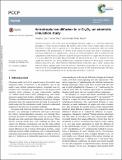Anisotropic ion diffusion in [alpha]-Cr₂O₃: an atomistic simulation study
Author(s)
Wells, Daniel; Cao, Penghui; Short, Michael P
DownloadMain article after revisions (2.594Mb)
OPEN_ACCESS_POLICY
Open Access Policy
Creative Commons Attribution-Noncommercial-Share Alike
Terms of use
Metadata
Show full item recordAbstract
Chromia ([alpha]-Cr₂O₃) is one of the most technologically important oxides, as it is the basis behind the passivation of many structural materials like stainless steel. It both resists oxygen ingress and slows the release of metals from its substrate by its high density and very low diffusivities. Were any further improvement to the protectiveness of chromia to be realized, no matter how small, it would have an enormous impact due to its ubiquitousness. Here we use molecular dynamics (MD) in conjunction with nudged elastic band (NEB) calculations to study the diffusion mechanisms of oxygen and chromium ions in [alpha]-Cr₂O₃. Significant anisotropic diffusion between the ab -plane and the c-axis is observed for both oxygen and chromium ions. We found that vacancy-mediated ion diffusion in the ab -plane is faster than diffusion along the c -axis, while interstitial-mediated diffusion along the c-axis is faster. Vacancy and interstitial defect migration paths unveil the atomistic mechanisms responsible for this anisotropic ion diffusion, as the most energetically favorable diffusion p ath accounts for the observed anisotropy. The results of this study have profound implications fo r the reduction and control of corrosion.
Date issued
2017-02Department
Massachusetts Institute of Technology. Department of Materials Science and Engineering; Massachusetts Institute of Technology. Department of Nuclear Science and EngineeringJournal
Physical Chemistry Chemical Physics
Publisher
Royal Society of Chemistry (RSC)
Citation
Cao, Penghui, Daniel Wells, and Michael Philip Short. “Anisotropic Ion Diffusion in α-Cr2O3: An Atomistic Simulation Study.” Physical Chemistry Chemical Physics 19, no. 21 (2017): 13658–13663.
Version: Author's final manuscript
ISSN
1463-9076
1463-9084